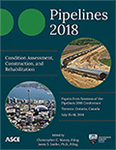Pipelines 2018
A Rational Approach to Designing Spray Applied Polymeric Manhole Rehabilitation Products
Publication: Pipelines 2018: Condition Assessment, Construction, and Rehabilitation
ABSTRACT
Polymeric coatings consisting of epoxies, polyurethanes, and polyureas have been utilized in the municipal industry for years to rehabilitate manhole structures, typically with the intent of arresting infiltration and maintaining the structural stability of the manhole/soil structure. While spray applied products are an effective means of controlling infiltration and arresting deterioration, their use as fully structural solution is sometimes limited by practical installation and product limitations. As a result, the use of spray applied polymeric coatings as a fully structural rehabilitation system and specifically their use in non-circular applications can result in liner thicknesses exceeding the practical limits for application resulting in both installation issues and increasing costs. Recent experiences in the North American manhole rehabilitation market has highlighted a trend of adopting the North American sewer rehabilitation terminology of full and partial deterioration for describing host manhole conditions and liner structural requirements. Since candidates for spray applied manhole rehabilitation systems are typically not in a state of incipient failure and receive considerable stabilization and repair efforts as part of the rehabilitation process, the use of fully deteriorated load models requiring the liner to support all applied overburden loads is often unnecessary and can render liners unbuildable. Due to their vertical orientation within the soil strata manhole structures and liners behave differently and are exposed to different applied load models than gravity pipelines making the use of North American pipeline rehabilitation design methods problematic. Further, when moving from circular to non-circular structures, specifically those with flat walls there is a need to address both applied bending stresses and liner deflection. The lack of formal guidance on both circular and non-circular manhole liner design has resulted in the authors of this paper to develop design procedures based on first principles, considering applied bending forces, end support conditions, and serviceability criteria. This paper strives to define a rational approach to developing design criteria for spray applied polymeric coatings as well defining appropriate applied load models for use in both circular and non-circular applications. Properly, matching existing structure condition with the appropriate load models and structural requirements is critical for ensuring both a successful and cost effective rehabilitation program.
Get full access to this article
View all available purchase options and get full access to this chapter.
REFERENCES
ACPA 1998, Concrete Pipe Handbook – Fifth Printing (1998), American Concrete Pipe Association (ACPA), Irving, TX, USA.
AWWWA C104-64 (1964), American Standard for Cement-Mortar Lining for Cast-Iron Pipe and Fittings for Water, Third Edition (1964), American Water Works Association (AWWA), New York, NY, USA.
AWWA M28 (2014), Rehabilitation of Water Mains, Third Edition (2014), American Water Works Association (AWWA), New York, NY, USA.
ASTM F1216-16 (2016), Standard Practice for Rehabilitation of Existing Pipelines and Conduits by the Inversion and Curing of a Resin-Impregnated Tube, ASTM International, USA.
ASCE 15-17 (2017), Stanadard Practice for Direct Design of Buried Precast Concrete Pipe Using Standard Installation (SIDD), American Society for Civil Engineers (ASCE), Reston, VA, USA.
Boot, J., Naqvi, M, and Gumbel, J. (2014), A New Method for the Structural Design of Flexible Liners for Gravity Pipes of Egg-Shaped Cross Section: Theoretical Considerations and Formulation of the Problem, Thin-Walled Structures 85 (2014) 411–418.
Ellison, D., Sever, F., Oram, P., Lovins, W., Romer, A. (2010), Global Review of Spray-On Structural Lining Technologies, Water Research Foundation, Denver, CO, USA.
Gumbel, J. (2001), New Approach to Design of Circular Liner Pipe to Resist External Hydrostatic Pressure, American Society of Civil Engineers (ASCE), Pipeline Division Specialty Conference 2001, San Diego, CA, USA.
Kampbell, N. (2015). The Practical Design Approach to Coatings and Liners for the Rehabilitation of Cylindrical-Shaped Manhole Structures, North American Society for Trenchless Technology (NASTT), No-Dig Conference and Exposition, Conference Paper TM2-04-03, USA.
NASA (1968), Buckling of Thin-Walled Truncated Cones, National Aeronautics and Space Administration (NASA), NASA SP-8019, USA.
Cooper, P., Dexter, C. (1974), Buckling of a Conical Shell with Local Imperfections, National Aeronautics and Space Administration (NASA), NASA TM X-2991, Washington, DC, USA.
Thepot, O. (2000), A New Design Method for Non-Circular Sewer Linings, Trenchless Technol. Res., Vol. 15, No. 1, pp. 2541.
Watkins, R., Anderson, L. (2000), Structural Mechanics of Buried Pipes, CRC Press, Boca Raton, FL, USA.
WRc (2001), Sewer Rehabilitation Manual – Volume II, Fourth Edition, Water Research Council (WRc), England.
Information & Authors
Information
Published In
Pipelines 2018: Condition Assessment, Construction, and Rehabilitation
Pages: 433 - 443
Editors: Christopher C. Macey, AECOM and Jason S. Lueke, Ph.D., Associated Engineering
ISBN (Online): 978-0-7844-8165-3
Copyright
© 2018 American Society of Civil Engineers.
History
Published online: Jul 11, 2018
Published in print: Jul 12, 2018
Authors
Metrics & Citations
Metrics
Citations
Download citation
If you have the appropriate software installed, you can download article citation data to the citation manager of your choice. Simply select your manager software from the list below and click Download.
